Lighthouses
Lighthouses
The appearance and size of lighthouses can vary a great deal, ranging from the tall approach lights on headlands to small harbour lights. Although the principal function of lighthouses is to aid navigation in the dark, they are often clearly visible, and hence useful, by day.
Most lighthouses are built on the coast at the beginning of harbour approach channels but some are found as orientation marks along the coast. Crooked
channels are equipped with smaller lights that may mark the navigable channel by sectors with different colours; red, green and white. The way a channel is marked by lights is not straightforward so it will be necessary to consult the chart.


![]()
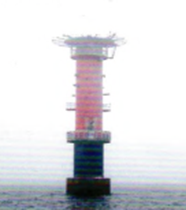
Minor ught A small light Approach light in fog
Coastal lighthouses often show only a white light. Channel lights help the Navigator by showing a white light for the navigable channel and green and red lights outside the channel.Approaching the light in the white sector/ you will have green to starboard and red to port. But variations are common , such as lights with only red and green sectors for a specific task, e.g. harbour entrances.
The intended use can be deduced from the chart. Leading lights may be found in narrow channels.
Lights that only shine occasionally are denoted by (Occas.). A light that is no longer in use but whose building is still visible, although perhaps partially ruined, is marked by (Exting.). Synchronised lights are marked by (Sync.).

The basic idea of sector lights is that when approaching the light the navigable channel is marked by the white sector, with green to starboard and red to port. But check on the chart!
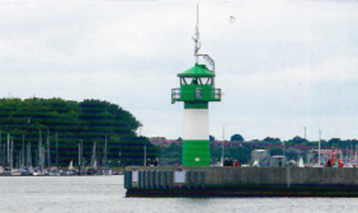

|
A lighthouse at a harbour entrance |
Light navigation notation for channel edgeа |
1. Light characteristics
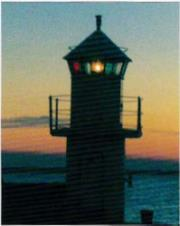
In order to distinguish between lights, they shine with different characteristics. An abbreviation beside the light symbol on the chart describes the character. Light descriptions consist of:
- A description of the light character, that is to say the relationship between light and dark intervals, expressed by an abbreviation.
- The colours that the light uses. W = white, R = red, G = green. The default colour is white. The distribution of sectors is shown on the chart..
- The period in seconds, i.e. the intervals of light and dark that occur from a given point in the light pattern until the same point reoccurs.
- The Nominal range is the distance to which the light is visible on a clear, dark night, with meteorological visibility of 10 miles.
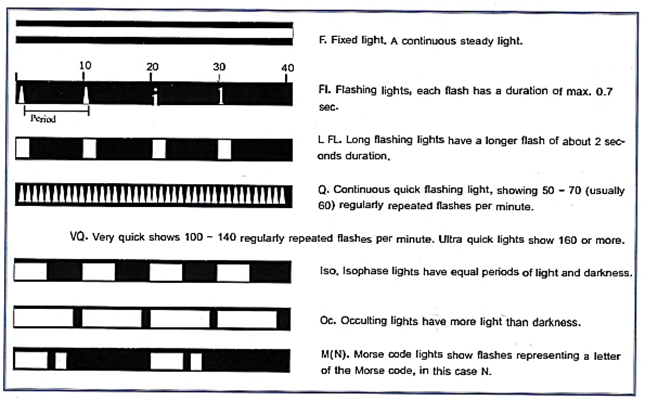
Several light characters may be grouped, i.e. a number of flashes followed by a longer period of darkness, or when Occulting, a number of dark periods
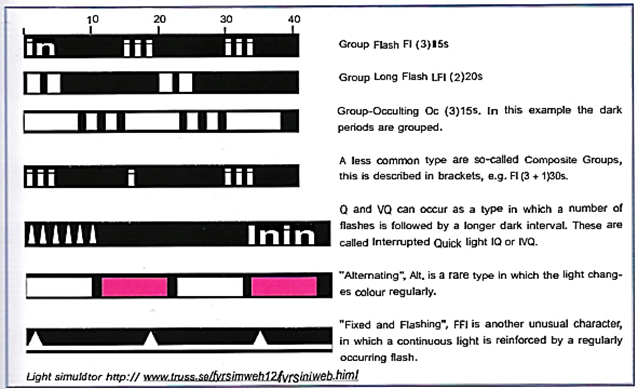
You can find out more about light characters in IALA Recommendation E-110 and Chart 1
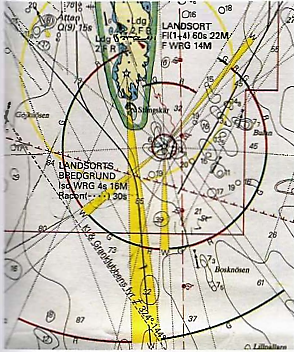
Landsort lighthouse symbol with two descriptions. The upper part refers to the character the main lighting, the lower one - to the auxiliary one, located in the same building. Landsorts Bredgund is equipped with Racon as well as a beacon
 The symbol for leading lights (Eng.), also called Range Lights (Amer.)
The symbol for leading lights (Eng.), also called Range Lights (Amer.)


Radar transponder beacon, with identifi cation responding on the 3-cm(X-)band
A Racon is a transponder beacon that emits a coded echo when hit by a radar energy. The echo shows up on the radar screen of the transmitting vessel. In this example the racon signal marks the channel under a bridge.
Although there are lights that emit through 360°, lights are more usually sectored using different colours and can also be blanked out (dark) in some direction. The principle is that the light shines with a white sector over the navigable channel and with green on starboard and red on port when travelling towards the light. The chart will show when the white sector shall be used. In twisting channels it is imperative to plan the use of the lights in advance!
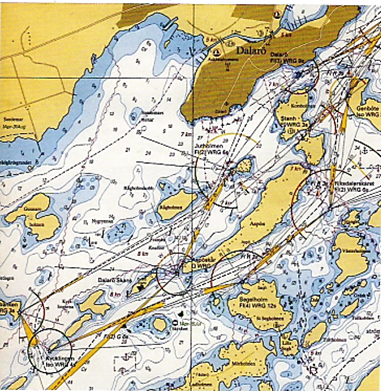
When the chart looks like this,you have to make a careful study of the sectors in advance!
Light lists describe the details of a light. Many countries publish their own fists and USA and Britain publish lists for the whole world. This is an extract from the American list; which can be accessed on the Interne

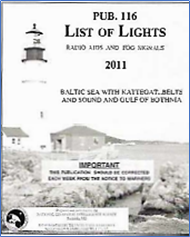
Lighthouses, buoys and harbour entrances may be equipped with sound-producing devices to help the mariner in periods of low visibility. But with increased use of GNSS they have decreased in importance over the last few years and some nations have decided to withdraw some of them. Depending of technical method to produce the sound, they are callled: Explosive (Explos),Diaphone (Dia), Horn (Horn), Siren (Siren), Whistle (Whis), Bell (Bell) and Gong (Gong).
 Description :1 bl. ev.of 30ssignal . (bl. 3for s, siexample . 27s). :
Description :1 bl. ev.of 30ssignal . (bl. 3for s, siexample . 27s). :
"Energy problems with the mark. When JANRA collided with the Troskeln Vastra in the morning of December 23, 2000, the edge mark was unlit and the racon did not work. These faults were observed in November 4, 2000 and thereafter the warning message "Remark Troskeln Vastra nr 6385 in Position 59° 39.58' N 019° 51.72' E, reported unlit" was sent by the authorities via Turku Radio and Navtex. " (Finnish investigation report B 5/2000 M) "
 +7 (812) 4-673-673
+7 (812) 4-673-673